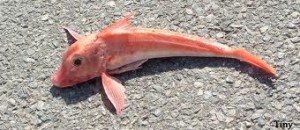How much should you care about where the fish you are served in a restaurant comes from? And how much do you find out about this from the menu, the serving staff and the restaurants website?
The answer to the first question is: a lot. And to the second: not much at all.
When the movie “ The End of the Line” came out in 2009, the media were Initially keen to take up the story about severely depleted fish stocks in our seas, and how this should inform choices that we consumers make in supermarkets and restaurants.
But media interest petered out, and today you don’t find too many stories on how supermarkets are moving to more sustainable fish supplies, and trying hard to educate their customers.
Today the campaign is being taken forward by a number of celebrity chefs, and the excellent pressure group Fish2fork, which ranks restaurants according to how sustainable is its menu, and the proprietors’ wider conservation ethic.
Fish2fork, run by the people behind The End of the Line, says it is the world’s first website to review restaurants according to whether their seafood is sustainable, and not just how it tastes.
New research suggests they may have the restaurant going public on their side. 70% of the respondents to a survey by Ohio State University researchers said restaurants should help protect the environment; more than 80 per cent expressed a willingness to pay extra if they were “green.”
“It is clear that green practices could be beneficial for restaurants,” said Jay Kandampully, co-author of the study and professor of consumer sciences at the University. “Customers want their restaurants to be environmentally friendly and say they’re willing to pay more for it.,”
Fish2fork publishes a league table of fish restaurants in the USA, the UK and Spain. Its top-rated restaurant , with a four blue fish designation (out of five) is Feng Sushi in Borough Market, London.
Fish2fork comments: “Since we first reviewed Feng Sushi and praised them for their efforts towards seafood sustainability, they have made even greater strides. Feng Sushi has achieved Marine Stewardship Council (MSC) certification as a group and is in the process of rolling-out several more MSC-approved species, including mackerel.”
“The tuna they offer is all hook and line caught yellow fin, and they are about to revise and update their sustainability commitment which appears on the menu and website.”
This is what Fish2fork said about another of its four blue fish rated restaurants, Fishworks: “This restaurant deserves full credit for serving organic salmon and Icelandic cod…they are clearly making an effort to make sustainability a priority, and they are trying to become as informed as possible.”
Of Eat Fish on Berkhamsted’s High Street, it says: “This seafood restaurant has some brilliant sustainability policies. Admirably, their seabass is line caught and traceable, caught on a boat called Maximus in Lowesoft. They serve sustainable species such as Sardines from the Cornish coast, Lemon Sole from Cornwall and they only have hand dived scallops.”
Fish2fork commends Loch Fyne for setting “the online standard for information about the seafood it sells. Its website is excellent and there is little reason to disbelieve what the company says about its attempts to source its seafood sustainably and in the least-damaging manner.
“The Loch Fyne chain scores highly because of exemplary fish choices: Icelandic cod, haddock from the North Sea , creel-caught langoustines, farmed queen scallops and dived king scallops.“
The website is equally candid on badly performing well-known high street chains ( you can, look them up, for yourselves).
Of one it remarks: “Information on the sustainability of the foods on offer is absent. Even the species of fish being used is sometimes left in doubt with the menu being as vague as to refer to ‘white fish’ is as one of the ingredients of a paella. Nor is there any attempt with the seafood dishes to show on the menu where the fishery was or the method of capture.”
“[it’s a] great shame that an organisation that could influence huge numbers of people on sustainability displays so little awareness of the problems facing marine life.”
Another big chain attracts this:“Cod, haddock and plaice are served without any indication as to the company’s sourcing policies – if it has any – so we have to assume the worst about its provenance.”
On its list of species it says we should avoid eating are Atlantic cod, Atlantic salmon , Atlantic halibut, Greenland Halibut,European eel, Atlantic bluefin tuna, European hake, sturgeon and caviar, Turbot and Shark species.
The list of species we can eat includes sardine or pilchard ,Gurnard, Black bream, seabream or porgy, Coley or saithe, Mackerel, Megrim, Pollack, Tilapia, brown trout and oyster. the group who
The MSC say “To help reduce the impact of fishing on fish stocks which are depleted choose line-caught fish where available.”

